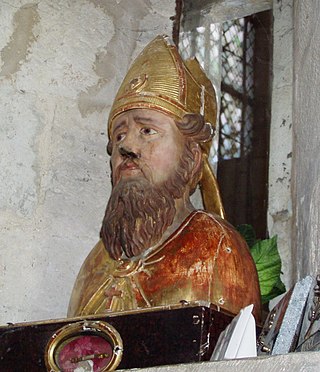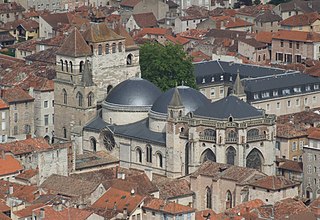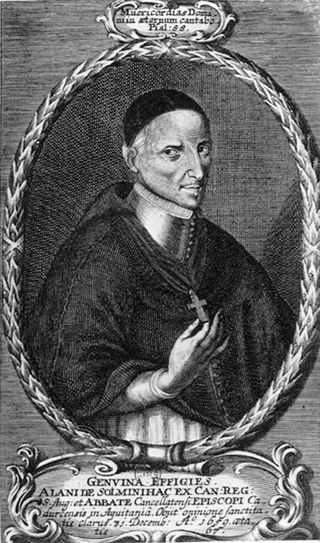
Pope Urban I, also known as Saint Urban (175?–230), was the bishop of Rome from 222 to 23 May 230. He was born in Rome and succeeded Callixtus I, who had been martyred. It was believed for centuries that Urban I was also martyred. However, recent historical discoveries now lead scholars to believe that he died of natural causes.
Primate is a title or rank bestowed on some important archbishops in certain Christian churches. Depending on the particular tradition, it can denote either jurisdictional authority or (usually) ceremonial precedence.

Louis Antoine de Noailles, Cardinal de Noailles, second son of Anne de Noailles, 1st Duke of Noailles, was a French bishop and cardinal. His signing of the Unigenitus bull in 1728 would end the formal Jansenist controversy.

Sulpicius II. the Pious was a 7th-century bishop of Bourges and saint.

St. Lucifer of Cagliari was a bishop of Cagliari in Sardinia known for his passionate opposition to Arianism. He is venerated as a Saint in Sardinia.
Saint Didier, also known as Desiderius, was a Merovingian-era royal official of aristocratic Gallo-Roman extraction.
The Council of Agde was a regional synod held in September 506 at Agatha or Agde, on the Mediterranean coast east of Narbonne, in the Septimania region of the Visigothic Kingdom, with the permission of the Visigothic King Alaric II.

Alexander of Jerusalem was a third century bishop who is venerated as a martyr and saint by the Eastern Orthodox Church, Oriental Orthodox churches, and the Roman Catholic Church. He died during the persecution of Emperor Decius.
The Archbishopric of Vienne, named after its episcopal seat in Vienne in the Isère département of southern France, was a metropolitan Roman Catholic archdiocese. It is now part of the Archdiocese of Lyon.

The Diocese of Cahors is a Latin Church diocese of the Catholic Church in France. The diocese comprises the whole of the department of Lot.

Marmoutier Abbey — also known as the Abbey of Marmoutier or Marmoutiers — was an early monastery outside Tours, Indre-et-Loire, France. In its later days it followed the Benedictine order as an influential monastery with many dependencies.

Saint Austregisilus (Outril(le), Aoustrille) (died 624) was bishop of Bourges from 612 to 624. His feast day is 20 May.
The Fifth Council of Orléans assembled nine archbishops and forty-one bishops. Sacerdos of Lyon presided over this council. The presence of these bishops indicates both the wide spread of Christianity in Gaul by the sixth century, and the increased influence of the Merovingian kings.

The Diocese of Rodez (–Vabres) is a Latin Church ecclesiastical territory or diocese of the Catholic Church in France. The episcopal see is in Rodez. The diocese corresponds exactly to the Department of Aveyron. Since 7 July 2022, the bishop of Rodez have been Luc Meyer, who was appointed by Pope Francis.

Berengar Fredol or Bérenger Frédol was a French canon lawyer and Cardinal-Bishop of Frascati.
Desideratus was a French saint from Soissons in the Christian church.
Felix of Bourges was a bishop of Bourges who later became recognized as a saint.
Saint Munderic of Arisitum was a Coadjutor at the Diocese of Langres between 539 and 572 and later a Bishop of Arisitum circa 600. He was a son of Ansbertus, a senator, and wife Blithilde.

Alain de Solminihac was a French Roman Catholic religious reformer and served as the Bishop of Cahors from 1636 until his death.
Ursicinus of Cahors or Urcis or Saint Urcsicinus was a bishop of Cahors from the early 580s until his death in around 595. His feast day is on December 13. Ursicinus was the chancellor of queen Ultragotha, wife of Childebert I, king of Paris. He was chosen by Maurilio, then-bishop of Cahors, to be his successor.











